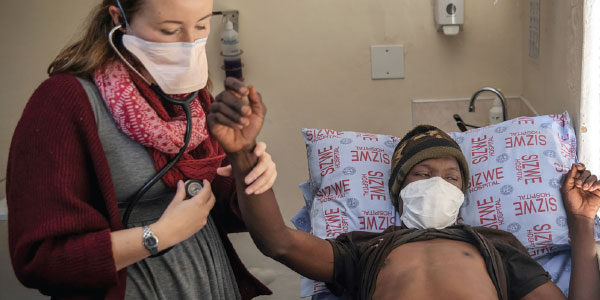
Five people in Olathe have tested positive for what was, at the dawn of the 20th century, the world’s “most feared disease.” Today, tuberculosis, once the leading cause of death is under control here in the U.S. But the disease, which is preventable and curable is still claiming lives elsewhere. In fact, it “has passed Covid as the top infectious disease killer,” according to an article in The New York Times three days ago.
Worldwide, 40% of people who are living with tuberculosis are undiagnosed and untreated, the Times article revealed, quoting the World Health Organization (W.H.O.). In 2021, the disease killed 1.6 million people and sickened 10.6 million. It’s now the 13th leading cause of death and is most prevalent in developing countries.
Risk factors associated with those countries include population density; undernourishment; stuffy, overcrowded living and work spaces; widespread unfamiliarity with general health knowledge; absence of adequate healthcare access; sparse sanitation; poor overall health; and lack of education. Poverty is a powerful determinant of tuberculosis, according to the W.H.O.
While infectious disease specialists here locally reassure that the public need not fear an outbreak of tuberculosis, they recommend knowing the symptoms and remaining vigilant and aware. Fatigue, cough, fever and unexplained weight loss are among typical symptoms. Stay home when feeling ill, health experts urge, and those who believe that they may have been exposed to tuberculosis are advised to get tested for the bacteria.
Deadly tuberculosis outbreaks in the U.S. 100 years ago were successfully battled. But as the five cases in Olathe illustrate, cases of the disease still occasionally crop up. It isn’t surprising. Tuberculosis is still a public health crisis in other countries, and people of the world are on the move. Gone are barriers to migration, travel and trade.
The situation offers a reminder of the importance of immunizations. They constitute a common-sense strategy to protect our own and the public health. It’s within our power to defeat deadly, transmissible diseases, such as tuberculosis, polio and measles. What is the strength of our will to put aside our various differences and work together against these common enemies?
Nota bene:
- “Ending TB is within reach – so why are millions still dying?” https://www.nytimes.com/2023/11/06/health/tuberculosis-tb-treatment-vaccine-diagnosis.html?searchResultPosition=1
- Schedules of child, adolescent and adult immunizations by age are available online from the Centers for Disease Control and Prevention in English, Spanish and other languages at https://www.cdc.gov/vaccines/schedules/hcp/imz/child-adolescent.html
Derrotar a nuestros enemigos comunes
Cinco personas en Olathe dieron positivo a lo que era, a principios del siglo XX, la “enfermedad más temida” del mundo. Hoy en día, la tuberculosis, que alguna vez fue la principal causa de muerte, está bajo control aquí en Estados Unidos. Pero la enfermedad, que se puede prevenir y curar, todavía se cobra vidas en otros lugares. De hecho, “ha superado a Covid como la principal enfermedad infecciosa que mata”, según un artículo publicado en The New York Times hace tres días.
A nivel mundial, el 40% de las personas que viven con tuberculosis no están diagnosticadas ni tratadas, reveló el artículo del Times, citando a la Organización Mundial de la Salud (OMS). En 2021, la enfermedad mató a 1,6 millones de personas y enfermó a 10,6 millones. Actualmente es la decimotercera causa de muerte y es más frecuente en los países en desarrollo.
Los factores de riesgo asociados con esos países incluyen la densidad de población; desnutrición; espacios de vida y de trabajo sofocantes y superpoblados; desconocimiento generalizado de los conocimientos generales de salud; ausencia de acceso adecuado a la atención médica; saneamiento escaso; mala salud general; y falta de educación. La pobreza es un poderoso determinante de la tuberculosis, según la OMS.
Si bien los especialistas en enfermedades infecciosas locales aseguran que el público no debe temer un brote de tuberculosis, recomiendan conocer los síntomas y permanecer alerta y conscientes. Entre los síntomas típicos se encuentran fatiga, tos, fiebre y pérdida de peso inexplicable. Los expertos en salud instan a quedarse en casa cuando se sienta enfermo, y a aquellos que crean que pueden haber estado expuestos a la tuberculosis se les recomienda hacerse una prueba de detección de la bacteria.
Los mortales brotes de tuberculosis que se produjeron en Estados Unidos hace 100 años se combatieron con éxito. Pero, como ilustran los cinco casos de Olathe, todavía surgen ocasionalmente casos de la enfermedad. No es sorprendente. La tuberculosis sigue siendo una crisis de salud pública en otros países y la gente del mundo está en movimiento. Atrás quedaron las barreras a la migración, los viajes y el comercio.
La situación ofrece un recordatorio de la importancia de las vacunas. Constituyen una estrategia de sentido común para proteger nuestra salud y la pública. Está en nuestro poder vencer enfermedades mortales y transmisibles, como la tuberculosis, la polio y el sarampión. ¿Cuál es la fuerza de nuestra voluntad para dejar de lado nuestras diversas diferencias y trabajar juntos contra estos enemigos comunes?
Nota bene:
- “Acabar con la tuberculosis está a nuestro alcance; entonces, ¿por qué siguen muriendo millones de personas?” https://www.nytimes.com/2023/11/06/health/tuberculosis-tb-treatment-vaccine-diagnosis.html?searchResultPosition=1
- Los calendarios de vacunación de niños, adolescentes y adultos por edad están disponibles en línea en los Centros para el Control y la Prevención de Enfermedades en inglés, español y otros idiomas en https://www.cdc.gov/vaccines/schedules/hcp/imz/child-adolescent.html









